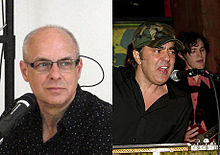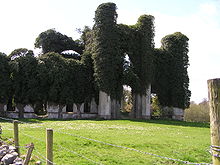The Unforgettable Fire
[4] Following their concert at Dublin's Phoenix Park Racecourse in August 1983, one of the final dates of the War Tour, lead vocalist Bono spoke in metaphors about the group breaking up and reforming with a different direction.
In the 10th issue of U2 Magazine, released in February 1984, Bono hinted at radical changes on the next album saying that he could not "sleep at night with the thought of it all" and that they were "undertaking a real departure".
"[3] After completing the War Tour in Japan late that year,[6] U2 rehearsed at Bono's seaside home in a Martello tower in Bray, County Wicklow.
[7] The castle's Gothic ballroom, which was originally built for music and had a 30-foot high domed ceiling, also attracted the band, as they were looking to capture the natural acoustics of a room in their recordings.
He'd come from Talking Heads, the Rhode Island School of Design, living in New York, and here was this Irish band hitting everything full on, completely earnest, hearts on sleeves, no irony at all.
[8] The equipment, which came in wheeling flight cases with removable lids, was described by Lanois as a "heavily modified Sound Workshop mixing console with a Stevens [sic] tape recorder".
[23] Eno was glad that the group began the sessions with only rough sketches of songs, as he was more interested in encouraging experimentation and improvisation than refining their ideas.
[13] The Edge said that they "didn't object to [Eno] taking liberties with what [they] had achieved up to that point", adding: "We were eager to learn and not precious at all about our sound or the way we worked.
[17] The producer encouraged U2 to work on their more unconventional material,[17] "champion[ing] the songs that didn't seem very U2-ish or things that had strong beginnings but no clear destination".
[13] Mullen called himself "not technically proficient" and appreciated Lanois spending time to develop his skills and encourage different approaches to playing drums.
[10] Lanois originally intended for the band to record entirely in the ballroom, which he described as a "beautiful very tall room with big mirrors, chandeliers and windows overlooking the river".
[18] Shortly after their arrival, the team realised that the ballroom had too much natural reverberation, necessitating the addition of sound absorption materials such as drapes to the walls.
[13] A Fairlight CMI synthesiser was used during the demoing phase out of convenience to help fill in placeholder textures and string ideas, marking the first time the instrument had been used on a U2 album.
[13][8][31] As Lanois was preparing to depart for London with the album tapes for mastering, Bono expressed interest in recording another take of his vocals for "A Sort of Homecoming".
He often encountered "No Entry" signs on doors and windows when attempting to film the group, forcing him to take a more artful, impressionistic approach to the documentary.
[33] Under Lanois's direction, Mullen's drumming became looser, funkier and more subtle, and Clayton's bass became more subliminal, such that the rhythm section no longer intruded, but flowed in support of the songs.
Like much of the album, the hard-hitting martial drum sound of War was replaced with a subtler polyrhythmic shuffle, and the guitar was no longer as prominent in the mix.
[22] Typical of the album, the track "The Unforgettable Fire", with a string arrangement by Noel Kelehan, has a rich, symphonic sound built from ambient guitar and driving rhythm, along with a lyrical "sketch" that is an "emotional travelogue" with a "heartfelt sense of yearning".
Bono felt songs like "Bad" and "Pride (In the Name of Love)" were best left as incomplete "sketches",[17] and he said that "The Unforgettable Fire was a beautifully out-of-focus record, blurred like an impressionist painting, very unlike a billboard or an advertising slogan.
At the end of a studio session, Eno overheard Clayton improvising a simple bass figure and recorded it "ad hoc" as it was being played.
The album took its name and much of its inspiration from a Japanese travelling exhibition of paintings and drawings at The Peace Museum in Chicago by survivors of the atomic bombs at Hiroshima and Nagasaki, Japan.
Where the latter opened with the shattering paramilitary drumbeat of 'Sunday Bloody Sunday',... Fire launches into the long shimmer of 'A Sort Of Homecoming,' whose sort-of-mystical lyric adorns the romantic maroon-and-gold sleeve.
"[60] Kurt Loder was more critical in Rolling Stone: "U2 flickers and nearly fades, its fire banked by a misconceived production strategy and occasional interludes of soggy, songless self-indulgence.
"[56] The Village Voice critic Robert Christgau felt Bono's moralizing and "wild romantic idealism" proved careless, specifically on "Pride" and "Elvis Presley and America", but concluded that those qualities work well enough for him throughout the rest of the album "to make a skeptic believe temporarily in miracles".
Consisting of six legs and 112 shows, the tour commenced in New Zealand in August 1984 where translating the elaborate and complex textures of the new studio-recorded tracks to live performance proved to be a serious challenge.
Although the group initially believed they had "blown it", it was, in fact, a breakthrough moment for them, showing a television audience of millions the personal connection that Bono could make with fans.
Retrospectively, Bill Graham of Hot Press wrote in 1996 that The Unforgettable Fire was U2's most pivotal album and that it was "their coming of age that saved their lives as a creative unit.
"[68] Ryan Dombal of Pitchfork praised The Unforgettable Fire as "a transitional album of the highest magnitude" which "ebbs and flows along the spectrum between the spiky, post-punk U2 of old and the impressionistic, Eno-assisted U2 they were yearning to become.
"[54] In 2023, Robert Crawford of American Songwriter ranked The Unforgettable Fire U2's fourth-best album, calling it "soft-hued and shimmering, balanced equally between moody song sketches and sharply-written singles" and crediting the change in producers for contributing to the band's development.
All lyrics are written by Bono; all music is composed by U2Notes In 1995, Mobile Fidelity Sound Lab remastered the album and released it as a special gold CD.








